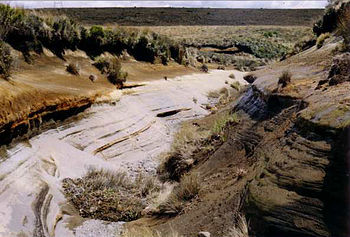Volcanic plateau

A volcanic plateau is a plateau produced by volcanic activity. There are two main types: lava plateaus and pyroclastic plateaus.
Lava plateau

Lava plateaus are formed by highly fluid
shield volcanoes and other volcanic landforms. In some cases, a lava plateau may be part of a single volcano. An example is the massive Level Mountain shield volcano in northern British Columbia, Canada, which covers an area of 1,800 km2 (690 sq mi) and a volume of 860 km3 (210 cu mi).[1]
Perhaps the most extensive of all the
Thulean Plateau, is generally believed to have been broken up by foundering of the Earth's crust to form the present ocean basin
.
Earth features numerous subaerial and
Columbia River Plateau (subaerial) and the vast Ontong Java Plateau
(submarine).
Pyroclastic plateau
Pyroclastic plateaus are produced by massive pyroclastic flows. They are underlain by pyroclastic rocks: agglomerates, tephra, volcanic ashes cemented into tuffs, mafic or felsic. Pyroclastic plateaus are also called ignimbrite plateaus.
Examples include the Shirasu-Daichi, which makes up almost all of southern Kyūshū, Japan,[3] and the North Island Volcanic Plateau in New Zealand.
See also
- Lava field – Large, mostly flat area of lava flows
- Cézallier massif – Volcanic plateau from France
References
- ISBN 0-521-43811-X.
- ^ Brittle tectonism in relation to the Palaeogene evolution of the Thulean/NE Atlantic domain: a study in Ulster Retrieved on 2007-11-10
- ^ "Kyushu -- GLGArcs". www.glgarcs.rgr.jp.
